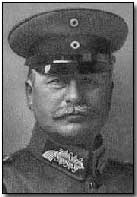Who's Who - Georg von der Marwitz
 Georg von der Marwitz
(1856-1929), a former cavalry commander, served on both Western and Eastern
Fronts during the First World War, leading the German Second Army from
December 1916 to September 1918.
Georg von der Marwitz
(1856-1929), a former cavalry commander, served on both Western and Eastern
Fronts during the First World War, leading the German Second Army from
December 1916 to September 1918.
Marwitz, who received his commission into the German Army in 1875, attended the War Academy prior to undertaking a succession of staff appointments intermingled with field commands. His background was firmly cavalry, and he led a cavalry regiment for five years from 1900 before being appointed Chief of Staff of XVIII Corps.
Marwitz began the Great War in August 1914 with the rank of Major-General, having acted as the army's Inspector-General of cavalry since 1912. However the war on the Western Front, where he was initially posted at the head of a group of cavalry divisions, did not lend itself well to cavalry as a form of offensive warfare, as he discovered at the Battle of Haelen in Belgium (the first cavalry engagement of the war) on 12 August 1914.
However his cavalry did serve to protect the flank of First Army during its retreat in the wake of the First Battle of the Marne.
Consequently Marwitz's cavalry group was dissolved by the German high command in December 1914. Marwitz was dispatched to the Eastern Front in command of the newly-established XXXVIII Reserve Corps, where it was believed that the cavalry would fare better.
Following action at the Second Battle of the Masurian Lakes in February 1915 - where he won the prestigious Pour le Merite - Marwitz was sent to the Carpathians at the head of a specially assembled ski corps.
Transferred back to the Western Front in autumn 1915 (following bouts of intermittent illness) Marwitz was charged with leading VI Corps from November, although the posting was brief, being sent back to fight in the East against the initially successful Russian Brusilov Offensive of June 1916.
In December 1916 Marwitz was once more given a command on the Western Front, this time leading Second Army. It was Second Army who saw most service during the November 1917 British-led (and innovative) Battle of Cambrai; Marwitz's subsequent counter-attack was sharp and effective.
However Second Army performed far less satisfactorily during the German spring offensive of 1918, where Second Army's failure to secure the fall of Amiens (in particular the critically important railway junction) in the centre of the German line compromised the whole of Ludendorff's planned advance.
The British counter-attack of 8 August at the Battle of Amiens was spectacularly successful, and amounted to what Ludendorff termed "the black day of the German Army".
Marwitz nevertheless retained command of Second Army in the immediate aftermath of its disaster, but was transferred to command of Fifth Army at Verdun six weeks later, retreating from combined U.S. and French forces. (Click here to read an address by Marwitz during the Meuse-Argonne Offensive.)
With the end of the war, and defeat, Marwitz chose to retire in December 1918.
Photograph submitted by Jonathan Viser
Both British and German fleets had around 45 submarines available at the time of the Battle of Jutland, but none were put to use.
- Did you know?
